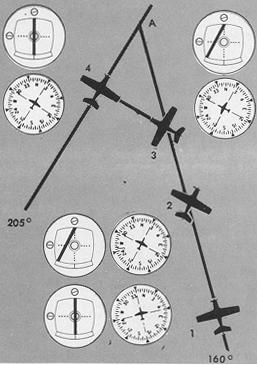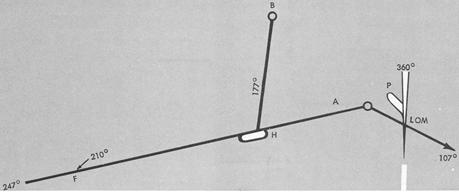
If your desired course is not the one that you are flying, you must orient yourself with respect to the VOR station and the course to be flown and work out a course interception problem. The following steps may be used to intercept a predetermined course, either inbound or outbound: (Steps 1-3 may be omitted if you turn directly to intercept course without initially turning to parallel the desired course.)
1. Turn to a heading to parallel the desired course, in the same
direction as the course to be flown.
2. Determine the difference between the radial to be intercepted
and the radial on which you are located.
3. Double the difference to determine the interception angle
which will be not less than 20° or greater than 90°.
4. Rotate the OBS to the desired radial or inbound course.
5. Turn to the interception heading.
6. Hold this magnetic heading constant until the CDI centers,
indicating that the aircraft is on course. (With practice in judging the
varying rates of closure with the course centerline, you learn to lead
the turn to prevent overshooting the course.)
7. Turn to the magnetic heading corresponding to the selected
course, and follow tracking procedures inbound or outbound.
Course interceptions are illustrated in Figures 8-9 and 8-10
with instrument indications shown at various stages.
Application of Basic VOR Procedures (Fig. 8-11). Assume that you are tracking inbound on the 247 radial of VOR "A", using a single VOR receiver. You expect to hold at intersection "H" and transition from VOR "A" to the Outer Compass Locator for a localizer approach on the instrument landing system shown.
Plotting Position (VOR). Since magnetic bearings are read directly from the VOR indicator, you can easily establish a fix on the 247 radial of VOR "A" by identifying the intersecting radial of VOR "B" and plotting your position on the Enroute Chart. At point "F", your receiver will read "FROM" with the OBS set on 210 and the CDI centered. With your position established and time noted, the distance from "F" to the holding fix "H" can be measured on the Enroute Chart and your ETA at "H" confirmed or revised.
Figure 8-9. Course interception (VOR).
 |
Intercept the 205 radial of VOR A, inbound-
1. Present position, inbound on 160 radial.
2. Turn right to parallel inbound course. (205° plus 180°
equals 025°). Difference between 160 and 205 equals 45°. (double
45 for interception angle of 90°). Turn to 295° (205° plus
90°).
3. Maintain heading of 295° until 205 radial is intercepted
(OBS 025, needle centered).
4. Track inbound on 205 radial.
Figure 8-10. Course interception (VOR).
 |
Intercept the 146 radial of VOR B, inbound-
1. Present position, crossing 171 radial.
2. Turn right to parallel inbound course. (146° plus 180°
equals 326°). Difference between 146 and 171 equals 25°. (double
25 for interception angle of 50°). Turn to 016° (326° plus
50°).
3. 146 radial is intercepted when CDI centers with OBS at 326;
turn to inbound heading of 326.
4. Track inbound on 146 radial.
Figure 8-11. Application of VOR procedures.
 |
Holding (VOR). If your VOR equipment is limited to one receiver,
it is especially important that you establish your inbound heading for
accurate course following while you orient yourself to the 177 radial of
VOR "B". To prevent overshooting the fix for holding entry, your position
checks and tuning will have to be done accurately and quickly. You can
easily misinterpret your position with respect to the 177 radial if you
fail to set the OBS correctly. When establishing a fix or intersection
by means of VOR stations on either side of your course, the TO/FROM indicator
will read "FROM" and the CDI will always be deflected toward the station
as you approach the fix, if the OBS is set with the radial (not the reciprocal)
under the index (Fig. 8-12).
Roll into a standard-rate turn to the right as the CDI centers.
As you roll out on the outbound heading, check the CDI to determine the
position of the 177 radial. Then tune in VOR "A", setting the OBS on 067.